OCZ Agility 4 (256GB) Review
by Kristian Vättö on September 1, 2012 1:00 PM ESTAnandTech Storage Bench 2011
Last year we introduced our AnandTech Storage Bench, a suite of benchmarks that took traces of real OS/application usage and played them back in a repeatable manner. Anand assembled the traces out of frustration with the majority of what we have today in terms of SSD benchmarks.
Although the AnandTech Storage Bench tests did a good job of characterizing SSD performance, they weren't stressful enough. All of the tests performed less than 10GB of reads/writes and typically involved only 4GB of writes specifically. That's not even enough exceed the spare area on most SSDs. Most canned SSD benchmarks don't even come close to writing a single gigabyte of data, but that doesn't mean that simply writing 4GB is acceptable.
Originally we kept the benchmarks short enough that they wouldn't be a burden to run (~30 minutes) but long enough that they were representative of what a power user might do with their system. Later, however, we created what we refer to as the Mother of All SSD Benchmarks (MOASB). Rather than only writing 4GB of data to the drive, this benchmark writes 106.32GB. This represents the load you'd put on a drive after nearly two weeks of constant usage. And it takes a long time to run.
1) The MOASB, officially called AnandTech Storage Bench 2011—Heavy Workload, mainly focuses on the times when your I/O activity is the highest. There is a lot of downloading and application installing that happens during the course of this test. Our thinking was that it's during application installs, file copies, downloading, and multitasking with all of this that you can really notice performance differences between drives.
2) We tried to cover as many bases as possible with the software incorporated into this test. There's a lot of photo editing in Photoshop, HTML editing in Dreamweaver, web browsing, game playing/level loading (Starcraft II and WoW are both a part of the test), as well as general use stuff (application installing, virus scanning). We included a large amount of email downloading, document creation, and editing as well. To top it all off we even use Visual Studio 2008 to build Chromium during the test.
The test has 2,168,893 read operations and 1,783,447 write operations. The IO breakdown is as follows:
| AnandTech Storage Bench 2011—Heavy Workload IO Breakdown | ||||
| IO Size | % of Total | |||
| 4KB | 28% | |||
| 16KB | 10% | |||
| 32KB | 10% | |||
| 64KB | 4% | |||
Only 42% of all operations are sequential; the rest ranges from pseudo to fully random (with most falling in the pseudo-random category). Average queue depth is 4.625 IOs, with 59% of operations taking place in an IO queue of 1.
Many of you have asked for a better way to really characterize performance. Simply looking at IOPS doesn't really say much. As a result we're going to be presenting Storage Bench 2011 data in a slightly different way. We'll have performance represented as Average MB/s, with higher numbers being better. At the same time we'll be reporting how long the SSD was busy while running this test. These disk busy graphs will show you exactly how much time was shaved off by using a faster drive vs. a slower one during the course of this test. Finally, we will also break out performance into reads, writes, and combined. The reason we do this is to help balance out the fact that this test is unusually write intensive, which can often hide the benefits of a drive with good read performance.
There's also a new light workload for 2011. This is a far more reasonable, typical every day use case benchmark. It has lots of web browsing, photo editing (but with a greater focus on photo consumption), video playback, as well as some application installs and gaming. This test isn't nearly as write intensive as the MOASB but it's still multiple times more write intensive than what we were running last year.
We don't believe that these two benchmarks alone are enough to characterize the performance of a drive, but hopefully along with the rest of our tests they will help provide a better idea. The testbed for Storage Bench 2011 has changed as well. We're now using a Sandy Bridge platform with full 6Gbps support for these tests.
AnandTech Storage Bench 2011—Heavy Workload
We'll start out by looking at average data rate throughout our new heavy workload test:

After going through all of our synthetic benchmarks, it shouldn't come as a surprise that the Agility 4 does not excel in our Storage Suites. Average write speed is fine, but read speed is from SATA 3Gbps era. Since the majority of IO operations of our Heavy suite are reads, the Agility 4 is slower than any other recent SATA 6Gbps SSD we have tested.
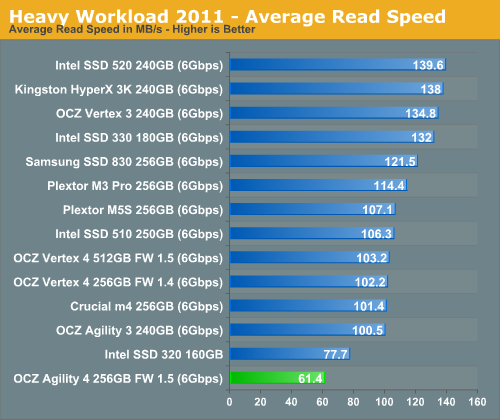
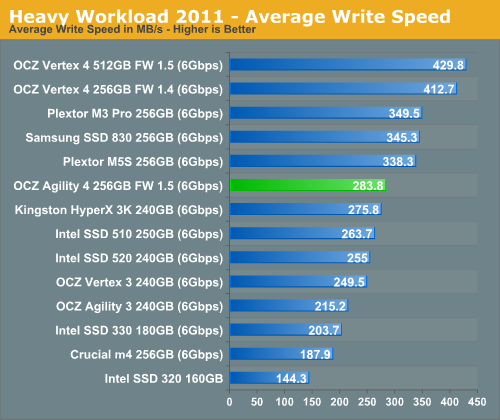
The next three charts just represent the same data, but in a different manner. Instead of looking at average data rate, we're looking at how long the disk was busy for during this entire test. Note that disk busy time excludes any and all idles; this is just how long the SSD was busy doing something:
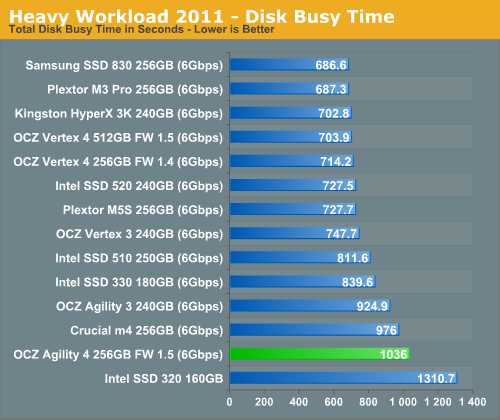
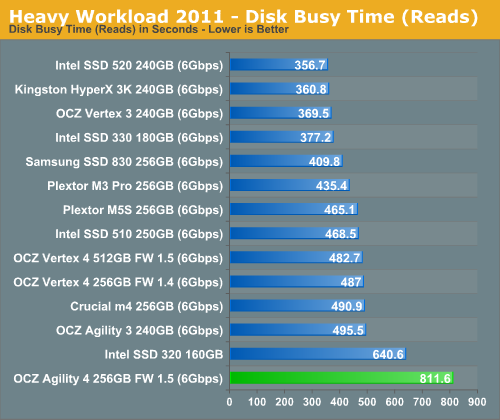
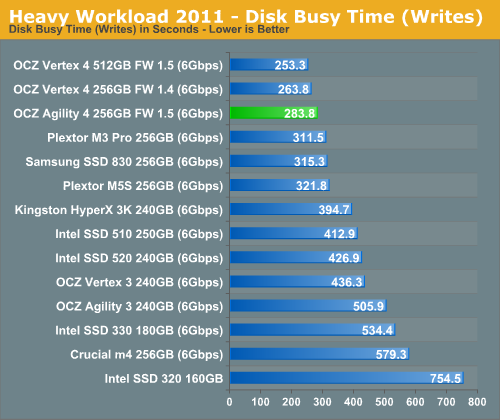










41 Comments
View All Comments
Wardrop - Sunday, September 2, 2012 - link
You guys should work on some kind type reporting method, e.g. when you highlight a portion of text in the article, is shows a button in the top-right (or bottom-right) of your selection with something like "report error". Clicking it yields a little popup form with a textarea and a submit button. On submit, it emails the author with the URL, the selected text containing the error, and the users comments.I'm not sure who your web developers is, but I personally wouldn't find this to be a difficult thing to implement in any of my Ruby applications (not Rails by the way), assuming you've already got some kind of popup framework. It'd be a matter of adding a bit of JavaScript into your article template/layout to handle the text selection button, and popup form. After that, it's just a matter of adding an endpoint on the server, e.g. http://www.anandtech.com/report_error/<article_... to handle the POST request and send the email off.
It would be a two hour job probably, but it depends on the framework you guys are using obviously, and the experience of your developer in doing this kind of thing.
Would be a worthy time investment considering that for every article, there's usually quite a number of typographic errors reported by users.
KZ0 - Sunday, September 2, 2012 - link
If not for any other reason - at least not to bloat the comment section with typo reports. I love how responsive you guys at AT are to comments and critizism, and how fast you respond, but reading about corrected typos isn't that interesting.maximumGPU - Tuesday, September 4, 2012 - link
Agreed!Impulses - Saturday, September 1, 2012 - link
I find their performance mode more disturbing than even SF's performance gap with compressible vs incompressible data... Conclusion makes total sense, it'd have to be a rather large discount for me to consider it or recommend it over the m4, 830, or M5S... Add to that all the PR problems OCZ still has due to being the first name a lot of people think of regarding last year's SF fiasco, and OCZ has a long road ahead to grab some positive mind share again.Zoomer - Saturday, September 1, 2012 - link
For these results to be valid, the drive has to be at most half full. Thus, this 256 GB drive would be effectively only have 128GB of usable capacity...throwing $/GB out the window.jb510 - Saturday, September 1, 2012 - link
I asked Anand about this drive a month or so ago in comparison to the Crucial m4. In part due to his reply I ended up buying a m4 and have been very happy with it. Still glad to see the full report of the agility4, it was tempting at the time both the m4 & a4 were $400 with the a4 being substantially newer to market.Runamok81 - Saturday, September 1, 2012 - link
In a move reminiscent of OCZs villainous 32nm / 25nm debacle,http://www.anandtech.com/show/4256/the-ocz-vertex-...
OCZ is shipping TWO flavors of this drive into the retail channel without informing consumers. It seems anandtech received the better performing (more reliable) micron NAND SSD. Why won't OCZ ship THEIR flavor of their drive for Anandtech to test?
http://images.tweaktown.com/content/4/8/4881_10_oc...
Along with its rumored increase in failure rates (tweaktown/newegg and amazon reviews), I'd be curious to see if there is a performance difference between the two flavors of the drives.
Fool me once, shame on you OCZ! Fool us twice, who should be ashamed?
hybrid2d4x4 - Saturday, September 1, 2012 - link
Asynchronous NAND drives had lower power consumption in past iterations - to what extent is this still true? How come there is no power consumption graph?Also, the A4 is slower overall in the storage bench tests than the Agility 3? What's going on here? This doesn't look like progress to me...
Kristian Vättö - Saturday, September 1, 2012 - link
Vertex 4 and Agility 4 require special power testing hardware which I don't have (our regular tools don't work with them for some reason).As for Agility 3 vs Agility 4, as I said in the article, Agility 3 gets away with async NAND because of real-time compression used by SandForce.
chris81 - Saturday, September 1, 2012 - link
Please make the same text which appears in all SSD reviews italic. It would ease skipping these:The four corners of SSD performance are as follows...